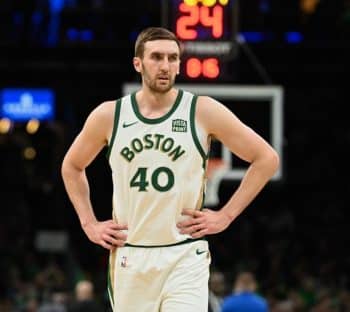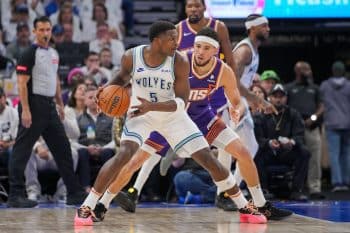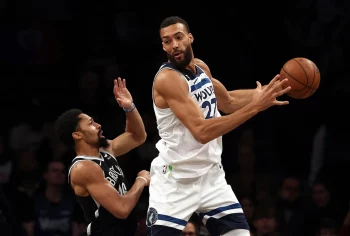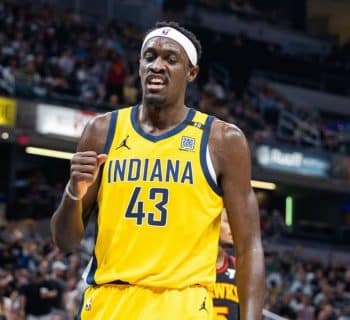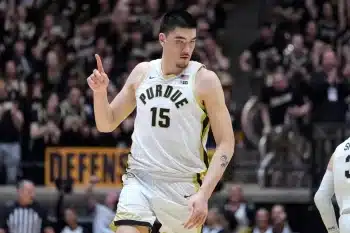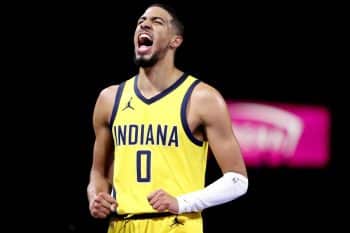NBA
Five NBA Small Forwards on the Rise in 2014-15
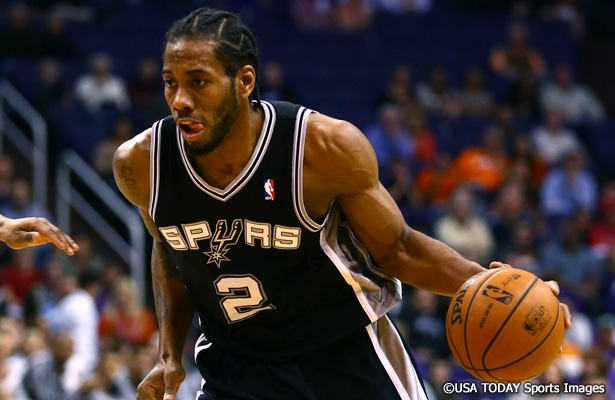
In the modern NBA, the small forward position has become one of the most important for teams. Small forwards need to be more versatile than ever before. They are often asked to guard some of the NBA’s biggest power forwards, and just as often asked to shut down some of the league’s elite point guards. Many of the better ball-handling forwards, such as LeBron James and Andre Iguodala, play “point-forward” and initiate their team’s offense intermittently with the full-time point guard.
LeBron James and Kevin Durant are the best two NBA players in the NBA, and by the far best small forwards. Behind them are players like Paul George (who may miss the upcoming season due to his recent leg injury) and Carmelo Anthony. However, behind these top small forwards is an exciting crop of young small forwards that are climbing the ranks and are ready to take the next step in their development. Some of them have been in the league for more than six years, some have yet to play their first NBA game.
Here is a look at some of the best up-and-coming small forwards in the league:
Kawhi Leonard, San Antonio Spurs (Age 23. Drafted 15th overall in the 2011) –
It is hard to express just how important Kawhi Leonard is to his team. For the last few seasons, Leonard has been a do-it-all sort of player. He spreads the floor with his three-point shooting, is a great defensive player (NBA All-Defensive second team), good rebounder, and has hands that look as though they belong to a center.
Leonard, who was acquired via a trade with the Indiana Pacers in exchange for point guard George Hill, really made a name for himself in last season’s NBA Finals. In the Finals, Leonard averaged 17.8 points on 61 percent shooting and became the youngest Finals MVP since teammate Tim Duncan won the award in 1999. He routinely guarded LeBron James, and made it difficult for James to impose his will on the game like he is accustomed to.
Shortly after winning the Finals, Spurs head coach Greg Popovich spoke highly of Leonard, and praised him for his work ethic.
“He’s a great learner and he’s super competitive, has a drive to be the best that’s really uncommon in our league,” Popovich said. “He walks the walk. I mean, he’s there early, he’s there late. He wants more. He wants me and the coaches to push him. So I just talked to him about not being in that defer sort of stage. The hell with Tony, the hell with Timmy, the hell with Manu, you play the game. You are the man.”
At just 23, Leonard really is “the man” now and for the foreseeable future in San Antonio. With a drive to be the best player he can be, and a humble demeanor, Leonard is well-situated to take his game to the next level next season and help the Spurs push for another championship.
Giannis Antetokounmpo, Milwaukee Bucks (Age 19. Drafted 15th overall in 2013) –
Too often NBA media and fans casually throw around phrases like “unlimited potential,” or “unlimited upside” when talking about young prospects. However, if there is one player in the NBA today that would warrant the use of such phrases, it is Giannis Antetokounmpo, otherwise known as the “Greek Freak.”
When Antetokounmpo was drafted by the Bucks, he was listed at 6’9. By June, Antetokounmpo had reportedly grown to just over 6’10, is now reportedly 6’11, and very well may keep growing since he is only 19 and his growth plates are still open.
But height isn’t everything. Players like Hasheem Thabeet are very tall, but not top-level NBA players. However, in his rookie season, Antetokounmpo showed on several occasions that he has the skill-set to utilize his height and length against defenses.
This type of length at the small forward position is a significant part of what makes Kevin Durant so dangerous. The Greek Freak has a long way to go to start being compared to Durant, but the tools are there.
Last season, Antetokounmpo averaged 6.8 points, 4.4 rebounds, 1.9 assists, 41.4 percent from the field, 34.7 percent from three-point range. He played in 77 games, and averaged 24.6 minutes a night. These numbers are by no means eye-catching, but last season was Antetokounmpo’s first time playing against elite basketball players after playing against what one league executive described as “YMCA” level talent.
Newly hired Bucks head coach Jason Kidd has said that he will expand Antetokounmpo’s role this season, and experimented with him at point guard during the Las Vegas Summer League. Antetokounmpo made a strong showing in Vegas, but has a ways to go before he can realistically play point guard effectively during the NBA season. Still, the possibilities really are limitless for Antetokounmpo. With an expanded role, his upcoming season could be a breakout year for Antetokounmpo.
Gordon Hayward, Utah Jazz (Age 24. Drafted 9th overall in the 2010) –
Gordon Hayward has significantly improved his game each of the four seasons he has been in the NBA. While Hayward may not be great at any single thing, he is a solid all-around player that still has plenty of room to improve.
Earlier this offseason, Hayward signed a max offer sheet with the Charlotte Hornets, which the Utah Jazz matched. The Jazz made a huge commitment to Hayward, who was looked to as a number one scoring option last season, as well as point forward.
Last season, Hayward averaged 16.2 points, 5.1 rebounds, 5.2 assists and 1.4 steals per game and shot 41.3 percent from the field, 30.4 percent from three-point range. These are very solid per game averages for a 24 year old forward. The major issue for Hayward was his shooting percentages, which plummeted from previous seasons.
To Hayward’s credit, he was adjusting to his role as the number-one option on the team and the focus of opposing teams’ defensive schemes. With young talent like Trey Burke, and Dante Exum now in Utah, there is a chance that Hayward will have less attention on him, and the opportunity to bring his shooting percentages back up next season. With Quin Snyder now coaching the team, the Jazz are more likely to increase the pace from last season, and spread the court more. With more possessions per game and more room to operate, it’s quite possible that Hayward will have a big season.
Chandler Parsons, Dallas Mavericks (Age 25. Drafted 38th overall in 2011) –
For the last few years, Chandler Parsons has been the best bargain in the NBA, making less than $1 million annually. Don’t feel too bad for Parsons, however, as he signed a three-year contract worth roughly $46 million this offseason with the Dallas Mavericks.
It is questionable whether Parsons is worth roughly $15 million annually under the new, restrictive CBA. However, Parsons enters this season with plenty of motivation to prove he is worth every penny after the Houston Rockets chose to not match the Mavericks’ offer sheet, allowing him to go to Dallas for nothing in return. Parsons knew the Rockets were looking for a third star player to put along James Harden and Dwight Howard, and thought that he could be that third star. The Rockets disagreed.
Last season, Parsons averaged 16.6 points. 5.5 rebounds, four assists and 1.2 steals per game, and shot 47.2 percent from the field, 37 percent from three-point range. He is a very good three-point shooter, a willing defender, and underrated athlete. In Dallas, Parsons will play alongside Raymond Felton, Monta Ellis, Dirk Nowitzki, and Tyson Chandler. Under the direction of one of the best coaches in the league in Rick Carlisle, Parsons has the opportunity to expand his game from floor-spacer and wing-defender to a primary scorer and playmaker.
In Houston, James Harden handles the ball and the offense runs mostly through him. When Harden is not taking the lead on offense, Howard is looking to score in the post. This left Parsons to be opportunistic with his scoring opportunities. It will be up to Parsons to find his niche with the Mavericks and show Houston they made a mistake in letting him leave.
Nicolas Batum, Portland Trailblazers (Age 25. Drafted 25th overall in 2008) –
Nicolas Batum is one of the best two-way players in the league, and arguably the best “glue-guy.” He does a little bit of everything for the Trailblazers, and is a huge reason why they advanced to the second round of the Playoffs last season.
One of the reasons why Batum flies under the radar is due to the fact that he is not a volume scorer (just 13 points per game last season). But on a team with Damian Lillard, Wesley Matthews, and LaMarcus Aldridge, Batum doesn’t need to score a lot. Instead, Batum spreads the floor with his three-point shooting, grabs rebounds at a high rate for a small forwards, sets up teammates as a playmaker, is great in transition both offensively and defensively, and often defends opposing teams’ best scorers, even if they happen to be a point guard. He even fills in at power forward quite often, allowing the Blazers to play at a quicker pace and add more three-point shooting.
Last season, Batum averaged 13 points, 7.5 rebounds, 5.1 assists and 0.9 steals, and shot 46.5 percent from the field, and 36.1 percent from three-point range. Batum was one of three players in the league last year to average over seven rebounds and five assists a game last year, along with Joahim Noah and Kevin Durant.
At age 25, Batum still has room to improve his game and take another step in his development. He is one of the most versatile players in the league, but he would really turn heads if he can get his scoring average up. However, on a high-scoring Portland team, it’s not really necessary for him to do so. But for Batum, a bump in nightly scoring to somewhere near 17 points a game would put more attention on his all-around impact on the game, and earn him the recognition he already deserves.
Batum has improved his production each season and projects to continue that upward trend with the up-and-coming Blazers this upcoming season.
Honorable Mention:
Tobias Harris, Orlando Magic (Age 22. Drafted 19th overall in 2011) –
Tobias Harris is by no means a household name, but may become more familiar to casual NBA fans this upcoming season.
Harris suffered through an ankle injury early last season and reportedly never fully recovered. Nevertheless, in 61 games played last season, Harris averaged 14.6 points, seven rebounds, 1.3 assists and shot 46.4 percent from the field in 30.3 minutes per game. These were career best numbers for Harris, who is reportedly now 100 percent healthy entering the upcoming season.
Harris is a gifted scorer, but will need to improve his three-point shooting to hit the next level in his development. This is especially true since teammate Maurice Harkless will be competing with Harris this upcoming season for playing time at small forward. Harkless shot 38.3 percent from three-point range last season, and successfully guarded some of the best players in the league. As a talented 3-and-D prospect, Harkless could take some significant playing time away from Harris if he is unable to stretch the floor out to the three-point line.
At age 22, Harris has a lot of potential to improve and become a major piece for the Orlando Magic moving forward. With a clean bill of health and a little bit of luck, this year may be a big one for Harris.
Andrew Wiggins, Minnesota Timberwolves (Age 19. Drafted 1st overall in 2014) –
Andrew Wiggins has been in the headlines for the last few months because of the rumored trade that officially sent him to the Minnesota Timberwolves earlier this week. With the deal done, now the focus can turn back to Wiggin’s game and potential.
Without seeing Wiggins in a real NBA game yet, it is hard to say how effective he will be this upcoming season. However, it is fair to say at this point that he will be an above average defensive player in his rookie season, and will have nights where he shows flashes of the player he may become one day.
In his one season at Kansas, Wiggins averaged 17.1 points, 5.9 rebounds, 1.5 assists, 1.2 steals, and one block per game, and shot 44.8 percent from the field, and 34.1 percent from beyond-the-arc. These are good numbers for a first-year college player, but fell short of the lofty expectations of scouts and analysts. One of the major criticisms of Wiggins is his laid-back demeanor and reluctance to take over games as a scorer. However, Wiggins seems to want to address this issue, and, according to ESPN, conveyed that sentiment to Kansas coach Bill Self before officially being traded to the Timberwolves.
“When all this trade stuff started, I talked to Andrew and Andrew told me, ‘I hope I get traded,'” Self said. “And I’m like, ‘No you don’t.’ And he said, ‘Coach, I do. It’s better for me, knowing my personality and what I need to do, to go somewhere where I’m forced to be something as opposed to going in there where they’re going to be patient with me and I’m going to be a piece.’”
It is not clear what kind of NBA player Wiggins will be in his rookie season. But if he can prove the naysayers wrong and take on an alpha dog mentality, Wiggins will likely be much more than just another “piece” next season in Minnesota.
Jabari Parker, Milwaukee Bucks (Age 19. Drafted 2nd overall in 2014) –
Many NBA scouts and analysts believe that Jabari Parker is the most NBA ready player in this year’s rookie class. Parker is a gifted scorer who can knock down a catch-and-shoot three-pointer or just as easily score with his back to the basket in the post.
In his one season at Duke, Parker averaged 19.1 points. 8.7 rebounds and 1.2 assists, and shot 47.3 percent from the field, and 35.8 percent from beyond-the-arc. At 6’8, Parker has ideal size to play small forward, and is strong enough to play power forward as well. It will be interesting to see how Milwaukee head coach uses Parker this upcoming season, particularly with teammate Giannis Antetokounmpo. Both Parker and Antetokounmpo have the size to play both forward positions, but each player is gifted in distinct ways.
Fortunately for Kidd and the Bucks, Parker and Antetokounmpo are both skilled enough that they should be able to find success in whatever role they are given. Parker, like all NBA rookies, will have stretches where he will struggle to assert himself– particularly on defense where he needs to improve– but will have as good of a chance as any rookie to make a strong impact next season.
These are some of the young, stand-out small forwards that are primed to have a big season. For some, next season may be a small step towards reaching their full potential. But for others, next season could be the year where they make the leap into elite echelon of the NBA.
Who do you think is going to breakout at the small forward position next year? Leave your thoughts below!
